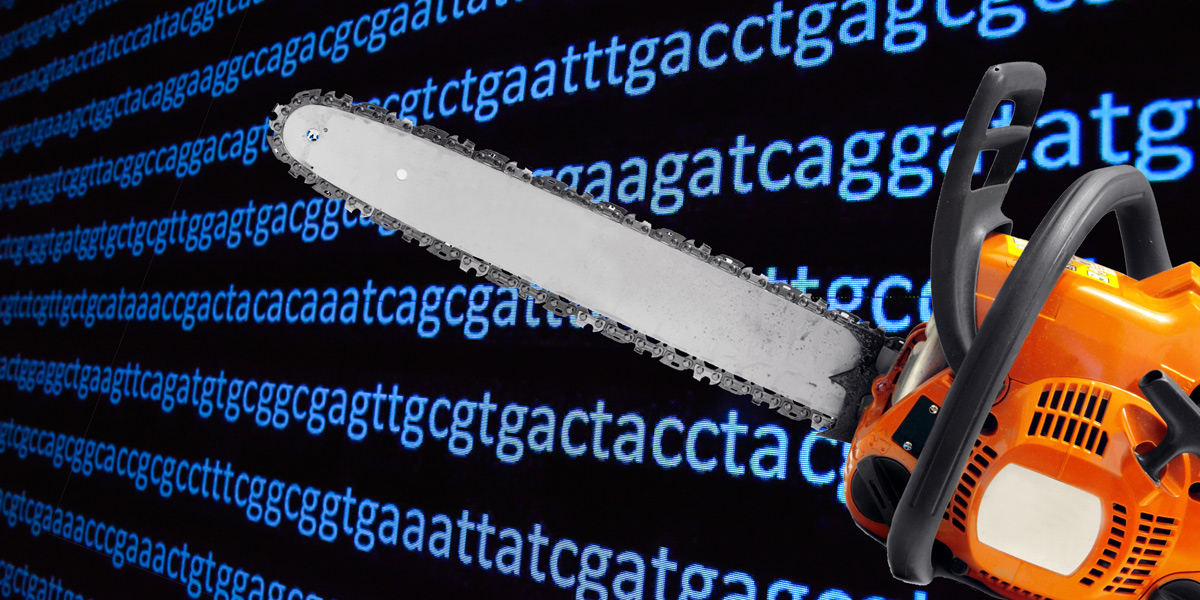
DNA base editors not as safe as previously thought
The past few years have seen a large number of research articles showing that the CRISPR gene-editing tool, designed to make a double-strand break in the DNA in a targeted location, may also cause many unintended mutations (damage to DNA).
Genetic engineers have tried to get around this problem by adapting the CRISPR gene-editing tool so that it no longer makes a double-strand break in the DNA. One adaptation consists of piggybacking onto the CRISPR tool an enzyme that changes individual DNA bases (so called “base editing”).
Base editing has been touted as a way of introducing changes in genes while avoiding the unintended effects, such as large deletions or rearrangements, which can arise from DNA repair processes following the usual CRISPR-induced double-strand DNA break.
However, two new papers (see references below) published in Science show that CRISPR base editing introduces more unwanted mutations than expected in mouse embryos and rice plants. The mistakes occurred in places where the editing tool wasn’t supposed to make changes. Another tested base editor did not make the undesirable edits.
Specific stretches of DNA base sequences are represented by the letters A, C, G, and T. They constitute the genetic code and carry information about building an organism.
CRISPR base editors have been hyped as ways to manipulate crops or correct genetic diseases in people. As an article in Science News explains, base editors have been thought to be safer than the DNA-cutting editors, because they don’t actually cut DNA. But until now, no one has known how often these tools make off-target genetic changes. The new findings suggest that some base editors are not as precise as previously thought and that more work is needed before they are safe to use.
In the mouse study, researchers in China and California devised an experiment to test the number of off-target edits made by three types of CRISPR gene editors. For each test, researchers injected one of two cells in early mouse embryos with one of the editors. The team then separated edited and unedited cells from mouse embryos and deciphered the DNA from each group.
Cells edited with a DNA-cutting version of CRISPR/Cas9 contained no more mutations than unedited cells did, indicating that the enzyme Cas9 was cutting only where directed. Similarly, a base editor that changes the DNA base A (adenine) to G (guanine) didn’t cause additional mistakes, the researchers found.
But a base editor that changes the DNA base C (cytosine) to T (thymine) caused mutations 20 times as often as mutations arose in the unedited cells. The unwanted editing changed an average of 283 extra bases in each embryo. That’s an unintended mutation introduced at one in every 20 million DNA base units, according to chemical biologist David Liu, a Howard Hughes Medical Institute researcher at Harvard University. Liu led the team that originally created the base editors tested in the two studies, though he was not involved in either study.
Many of those mistakes happened in genes that were turned on or in DNA that was being copied when the base editor was introduced to the cell. Researchers studying the editors in rice also found additional mistakes from the cytosine, but not adenosine, base editor.
The Science News article compares the cytosine-altering enzyme to “a toddler throwing forbidden treats into a shopping cart when parents aren’t looking”, in that it “can grab single-stranded DNA that it gets close to and make edits on its own”.
David Liu told Science News, “The community needs these worst-case scenario pressure tests so we can make sure there’s a good margin of safety when these agents do enter clinical trials."
Regarding gene-edited food crops, the concerns with such unintended mutations are the introduction of unexpected toxins or allergens. Animal feeding studies from the first generation of GM crops repeatedly show unexpected toxicity and/or allergenicity.
The two new studies:
E. Zuo et al. Cytosine base editor generates substantial off-target single nucleotide variants in mouse embryos. Science. Published online February 28, 2019. doi:10.1126/science.aav9973. http://science.sciencemag.org/content/early/2019/02/27/science.aav9973
S. Jin et al. Cytosine, but not adenine, base editors induce genome-wide off-target mutations in rice. Science. Published online February 28, 2019. doi:10.1126/science.aaw7166. http://science.sciencemag.org/content/early/2019/02/27/science.aaw7166










